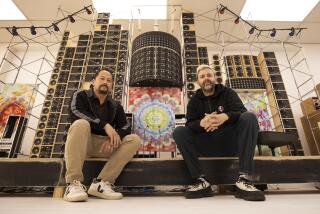Obscure Museum Revives Long-Lost Melodies
- Share via
In 19th-Century Europe, a stroller seized with an urge to make music had only to unsheath his walking stick and take out a long, skinny, violin-like instrument with its own bow. He could play it anywhere, any time.
A homebound musician might opt to play the harmonicons--sets of glasses of varying sizes that sounded musical notes when their rims were rubbed by wet fingertips.
And troops who fought in America’s Civil War could hear the music of bands marching in front of them because of horns that “backfired” over the players’ shoulders, toward the armies behind.
Some of the best of these rare and old instruments--including the only complete set of seven backfiring horns known to exist in the country--are among 750 in a little-known museum at the Claremont Colleges.
Ethnic Instruments
But the 2-year-old Fiske Museum of Musical Instruments is moving into national prominence, according to its curator, Albert Rice.
Although there may be hundreds of collections of unusual and old instruments from Europe and America, Rice said the Fiske is one of only nine museums in the country that also include important collections of ethnic instruments. Instruments from such areas as Tibet, China, Japan, Africa, Indonesia and South America are represented in the Fiske collection.
The only other comparable museum west of the Mississippi is at the University of South Dakota. Others are at the Metropolitan Museum in New York, the Smithsonian Institution in Washington, D.C., the Museum of Fine Arts in Boston, and a few in other Eastern cities.
“Many people right here in the colleges and in the community don’t even know of our existence,” Rice said. “We hope to become well-known so people will see us as a real asset.”
Since it was founded in 1986 with the colleges’ purchase of a collection of about 600 rare instruments, the Fiske Museum has had 150 donations that Rice called “important.”
“Just the other day we got a call from a man offering us a rare electronic organ,” Rice said. “He first called the Smithsonian but they already had one, so they referred him to us. It seems that as people get older they wonder what to do with some treasure they’ve been keeping, and then they find out about us.”
Eleanor Montague, vice president for administration and planning for Claremont University Center, said the museum is gaining in popularity. “It has surprised me,” Montague said. “It draws people like a magnet. Almost everyone has taken some kind of musical training as a child and has done the same for their children, so it has enormous public appeal.”
The museum is in the basement of Bridges Auditorium in the heart of the Claremont Colleges. It is funded by the Claremont University Center. A constantly changing display of hundreds of unusual instruments is in one large climate-controlled room that is open to the public on Mondays, Wednesdays and Fridays from 2 to 4 p.m. and on Tuesdays and Thursdays from 10 a.m. to noon.
Variety of Displays
Visitors of all ages come from elementary school classes to senior citizen tours, and from all over the country, Rice said.
Displays include some instruments of great value, such as a violin made by Andrea Guarneri in Cremona, Italy, in 1672 and the first modern solid silver flute, made in 1866. A recent acquisition is an intricately carved rosewood Chickering grand piano, made in Boston in 1850.
Curiosities, many of great value, include a “serpent”--a curved, snake-like bass horn that was a European predecessor to the tuba and sousaphone; a viola d’amore, similar to a violin, that was made in 1750 with two levels of strings; an early 19th-Century French hurdy-gurdy, Tibetan temple trumpets and Polynesian drums.
Most are kept in playing condition, said Rice, who runs the museum with its director, Patrick J. Rogers.
Some of the six Claremont Colleges, especially Scripps and Pomona, join the museum in sponsoring concerts, where some of the rare instruments are played by students. Pomona College and the museum will sponsor a concert April 9 in Bridges Hall of Music, and Scripps College will be a co-sponsor of another on April 23 in Balch Auditorium.
Montague said the museum is valuable because it offers music students unique opportunities for research.
The collection began during World War I when a Midwesterner, Curtis William Janssen, found an old German bugle. Janssen eventually acquired 552 rare instruments that he indicated he wanted housed in a private college west of the Mississippi after his death. He died in 1952. The Claremont Colleges bought the collection with private donations for about $10,000 in 1954, and Rice estimates its current value at about $500,000.
In addition to its permanent collection, the museum is showing three collections on loan from the Natural History Museum of Los Angeles County, the Hancock Memorial Museum at USC and the private collection of Irving Bush of Los Angeles.
More to Read
Sign up for Essential California
The most important California stories and recommendations in your inbox every morning.
You may occasionally receive promotional content from the Los Angeles Times.










